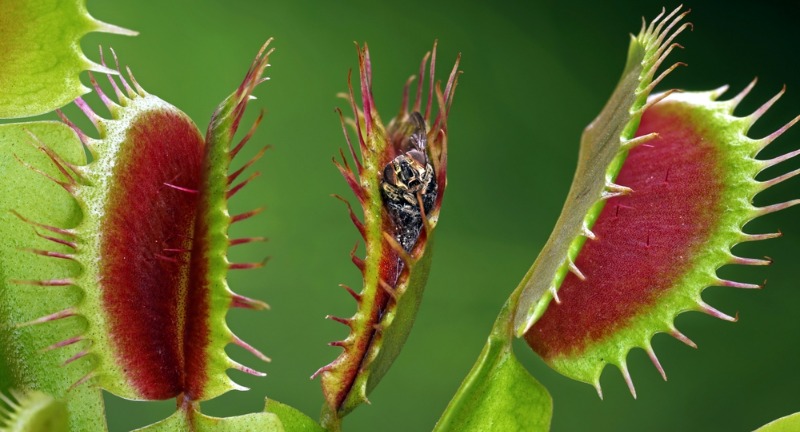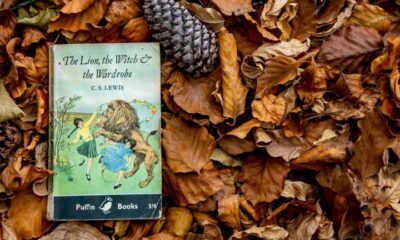LIFESTYLE
35 Plants That Help You Fight Off Pests From Your Home
Published
2 months agoon

Shutterstock
Let’s face it: these bugs have a knack for ruining a perfectly good day. Whether it’s mosquitoes turning your backyard barbecue into their personal buffet or ants deciding your kitchen counter is the best real estate in town, pests are the uninvited guests nobody asked for. But what if I told you there’s an army of plants ready to fight the good fight on your behalf? That’s right—nature has its own pest control squad, and it smells a whole lot better than bug spray. So grab your trowel, and let’s plant our way to a bug-free (and fabulously fragrant) life.
Dill

Shutterstock
Dill isn’t just a fragrant herb; it’s the perfect partner in crime for keeping your garden pest-free. Its strong scent repels mosquitoes, aphids, and cabbage worms, while its delicate, feathery fronds lure in ladybugs to do the heavy lifting. Together, they create a dynamic duo, with ladybugs feasting on aphids while dill keeps the rest of the pests in check. So, if you’re looking for a garden alliance that gets the job done, dill and ladybugs are here to save the day!
Lavender

Shutterstock
Lavender is more than just a pretty face in the garden; it’s a multitasking marvel. With its calming fragrance, this plant repels mosquitoes, flies, and even moths while doubling as a natural air freshener. Lavender thrives in sunny spots with well-drained soil, making it a low-maintenance choice for busy gardeners. Here’s a little surprise: its essential oil is so versatile that it was used in ancient Egypt as part of the mummification process. Turns out, lavender’s history is as rich as its scent.
Basil

Shutterstock
Basil isn’t just for elevating your pasta game; it’s also a fantastic ally in keeping bugs at bay. Its strong, peppery aroma confuses mosquitoes and flies, making your outdoor space much more enjoyable. Basil loves a sunny windowsill or garden patch with plenty of warmth and consistent watering, rewarding you with both culinary and pest-repelling perks. Surprisingly, basil was once thought to ward off scorpions—while we can’t vouch for that, it certainly makes a mean pesto!
Rosemary

Shutterstock
Rosemary is like the overachiever of the herb world—great in your cooking, lovely in your garden, and a natural bug deterrent. Its woody scent repels mosquitoes, flies, and even cabbage moths, making it a favorite for both home chefs and gardeners alike. This sun-loving, drought-tolerant plant thrives in warm climates but can also be grown in pots indoors if you give it plenty of light. Also, as a fun little twist: rosemary was once thought to improve memory so much that ancient Greek students would tuck sprigs of it into their hair before exams—but maybe they were onto something, because it’s hard to imagine anything more distracting than a mosquito buzzing in your ear!
Lemongrass

Shutterstock
Lemongrass is a powerhouse when it comes to repelling mosquitoes, thanks to its high citronella content—yes, the same stuff in those garden candles you light during summer evenings. This fast-growing grass thrives in warm, sunny climates and makes an excellent addition to your herb garden or patio. Plus, its citrusy aroma isn’t just for bugs; you can use it in teas, soups, and even desserts for a bright, zesty flavor. Here’s something you might not know: lemongrass oil can double as a natural polish for wooden furniture, leaving your home both bug-free and beautifully shiny!
Butterwort

Shutterstock
Butterwort might look like a delicate little rosette, but it’s a total menace to unsuspecting bugs. Its leaves are coated in a sticky, dew-like substance that traps gnats and other tiny pests, turning them into plant food—talk about a sweet but deadly combination! Interestingly enough, butterwort leaves can also help remove grease from your hands, so it’s not just bugs that get stuck. This low-maintenance carnivore loves bright, indirect light and thrives in damp conditions, making it a quirky and practical addition to your pest-fighting arsenal.
Marigold

Shutterstock
Marigolds are the garden’s version of a “No Trespassing” sign for bugs, especially nematodes and aphids. Here’s something unexpected: their roots release a natural chemical that can keep soil pests away for years, like a bug-banishing legacy. These cheerful blooms thrive in sunny spots and are as easy to care for as they are effective. Think of marigolds as the bouncers of your garden, and they’re not letting any pests past the velvet rope.
Garlic

Shutterstock
Garlic isn’t just a kitchen staple—it’s also your garden’s secret weapon against pests. The strong, pungent odor that makes garlic a flavor powerhouse is exactly what repels mosquitoes, aphids, and even deer from munching on your plants. The best part? It’s incredibly easy to grow, thriving in well-drained soil with plenty of sunlight. And here’s a fun twist: not only does garlic deter bugs, but it can also boost the growth of nearby plants, acting as a natural companion plant to your veggies. If the bugs are chatgetting bold, you can always add some garlic to your next dinner—and to your garden’s pest control plan!
Eucalyptus

Shutterstock
Eucalyptus isn’t just a koala’s favorite snack—it’s also a serious contender in the battle against pests. Its strong, aromatic leaves contain oils that mosquitoes and flies just can’t stand, making it a perfect addition to your outdoor garden or even a potted plant on your porch. While it’s known for its refreshing scent, eucalyptus actually prefers a bit of distance between itself and colder temperatures—so keep it in a warm, sunny spot to keep it thriving. And here’s the kicker: while you’re keeping the bugs away, the leaves can be dried and used to make soothing herbal teas that can clear your sinuses, too. Talk about a plant that does it all!
Sundew

Shutterstock
Sundew is a small but mighty predator that doesn’t just sit back and wait for bugs to come to it—it actively catches them! This plant’s distinctive, dewy, tentacle-like leaves are covered in tiny droplets that mimic nectar, luring insects right into their sticky trap. Once a bug lands, it becomes ensnared, and the sundew slowly curls around it to digest its meal. While it’s a fascinating addition to any garden, it’s also a top-notch insect repellent that doesn’t have to do much other than just be itself!
Sage

Shutterstock
Did you know that sage isn’t just a flavorful addition to your cooking? This plant has a secret talent: it’s a natural bug repellent! Bugs like mosquitoes, flies, and even certain pests that target your veggies can’t stand the strong scent of sage. If you’ve ever spent a summer evening swatting at mosquitoes, you’ll appreciate the power of this leafy herb. Just plant it near your porch or garden to keep the critters at bay, and you can enjoy outdoor meals without worrying about your food becoming an insect buffet. Sage: the herb that makes your garden both tasty and bug-free!
Chrysanthemum

Shutterstock
Chrysanthemums aren’t just a burst of color in your garden—they’re the secret agents of pest control. These vibrant blooms produce a natural compound called pyrethrin, which is so potent it’s used in insecticides to send bugs like ants, roaches, and ticks packing. Imagine your garden as an action movie, and chrysanthemums are the heroes taking down the bad guys, one pest at a time. And here’s the kicker: while insects run for cover, these hardy flowers will keep dazzling you with their showy blooms, proving that beauty and bravery can totally coexist.
Thyme

Shutterstock
There’s no thyme like the present to add thyme to your garden! This fragrant herb is not only a must-have for your kitchen, but it’s also a natural bug repellent that mosquitoes and flies just can’t handle. Its small, hearty leaves are perfect for attracting pollinators while keeping pests at bay, making it a win-win in any herb garden. Plus, thyme is pretty low-maintenance—it thrives in dry, well-drained soil and loves the sun, which makes it the perfect plant for gardeners who don’t have a lot of time (or thyme!) to fuss over it.
Allium

Shutterstock
Allium doesn’t just bring flavor to your dishes; it brings flavor to your garden’s defense system too! The pungent aroma of these oniony beauties is a big deterrent for aphids, mosquitoes, and other pests. Plant them near your roses or vegetables, and watch the bugs hightail it out of town. As an added bonus, allium’s spherical blooms add a touch of whimsy to your garden, proving that you can be both tough and charming at the same time!
Catnip

Shutterstock
Catnip is a plant that’s got some serious purr-sonality—and not just because cats go wild for it. While it’s famously known for driving felines into a playful frenzy, catnip’s insect-repelling powers are equally impressive. The plant’s strong scent, which is irresistible to cats, also keeps mosquitoes, flies, and even ants at bay. What’s cool about catnip, though, is that it’s not just a bug bouncer; it thrives in pretty much any soil and can even grow in poor conditions, making it the perfect low-maintenance addition to any garden or windowsill.
Fennel

Shutterstock
Fennel isn’t just for flavoring your pasta; it’s also a serious pest repellent with a bit of flair. The aromatic, feathery foliage sends mosquitoes and aphids running for cover, while its vibrant yellow flowers attract pollinators like bees and butterflies—talk about a plant that knows how to multitask! Fennel loves soaking up the sun and doesn’t need much attention, making it perfect for gardeners who want to protect their space with minimal effort. Plus, when it’s not busy warding off pests, fennel’s seeds can be used in cooking or even as a natural remedy for digestion—proving that this herb is both functional and flavorful.
Bay Laurel

Shutterstock
Bay laurel isn’t just a culinary superstar; it’s also a plant that knows how to kick pests to the curb. The strong, spicy aroma of its leaves is a natural deterrent for mosquitoes, flies, and even certain types of moths. Bay laurel thrives in sunny spots and well-drained soil, so if you’re growing it outdoors, it’ll love a little Mediterranean-style treatment—just don’t expect it to handle frost like a pro! Bay leaves were once used in ancient Greece to crown victorious athletes and scholars, but nowadays, they help celebrate a victory for your bug-free house!
Pennyroyal

Shutterstock
Pennyroyal is a small herb with a big attitude when it comes to pest control. Its minty scent makes mosquitoes, ants, and flies want to stay far, far away—pretty much like when you catch a whiff of someone’s perfume that’s just a bit too much. Pennyroyal thrives in loamy soil and loves a good dose of sunshine, so it’s perfect for those bright spots in your garden. The plant was once used in folk medicine for its cooling properties, but if you’re not careful, it can be a bit too potent—so treat it like a powerful, fragrant friend who knows how to keep the bugs away without overstepping!
Citronella

Shutterstock
Citronella is the ultimate mosquito repellent, famous for its citrusy scent that bugs just can’t stand. Often grown as a tall, grass-like plant, it’s perfect for lining pathways or filling outdoor planters where mosquitoes are most pesky. Citronella thrives in warm, sunny areas with well-draining soil and can be easily grown in containers for portability. While mosquitoes hate it, bees and butterflies love it, making citronella a surprising double agent in your garden—banishing pests while welcoming pollinators!
Mint

Shutterstock
Mint is like the cool kid at the garden party—everyone loves it, with the exception of bugs, of course! Its sharp, refreshing scent keeps mosquitoes, ants, and flies at a distance, while adding a burst of flavor to your teas and dishes. Mint is incredibly easy to grow, often spreading faster than you can say “mojito,” so it’s best to plant it in containers if you want to keep it from taking over. Fun fact: the leaves of mint are not only good for adding a zing to your recipes, but they also make a great natural remedy for headaches when applied to your temples!
Geranium

Shutterstock
Geraniums aren’t just eye-catching with their vibrant, colorful blooms—they’re also a great natural insect repellent. The strong scent of their leaves makes mosquitoes and flies think twice about invading your space, keeping your patio and garden pest-free. These plants thrive in sunny areas, and they’re known for being tough and low-maintenance, making them perfect for gardeners with a busy schedule. What’s even more impressive? Geraniums are often used to make essential oils that have a calming effect, so while they keep the bugs away, they’ll also help you unwind after a long day!
Tansy

Shutterstock
Tansy is a bold, no-nonsense plant that takes its job as a bug repellent seriously. Its strong scent drives away mosquitoes, flies, and even ants, making it a must-have for anyone looking to keep pests in check. Tansy thrives in full sun and will happily spread in your garden, so it’s perfect if you’re looking for an easy-care, pest-fighting powerhouse. Did you know that tansy has been used for centuries not just for pest control but also as a natural insecticide? It’s like having a garden defender with some serious old-school street cred!
Venus Flytrap

Shutterstock
The Venus flytrap is arguably one of the most iconic plants when it comes to deterring pests, thanks to its dramatic, jaw-like leaves. With those leaves, it snaps shut when an unsuspecting insect touches its sensitive hairs, trapping it inside for a slow and inevitable digestion. While it might sound a bit ruthless, it’s actually an incredibly efficient pest controller that doesn’t need much in return—just a little sunshine and moisture to keep its carnivorous tendencies alive. Plus, these quirky plants have a rapid response time, closing their traps in less than a second, which is faster than most gardeners can even blink!
Lemon Balm

Shutterstock
Lemon balm’s lemony scent doesn’t just freshen the air—it’s also a natural pest repellent, especially against mosquitoes. It’s packed with citronella, the same powerful compound found in many bug sprays, making it a must-have for anyone looking to keep pests away, naturally. This herb is a fan of sunny spots and thrives in well-drained soil, but it’s also pretty forgiving if you forget about it for a day (or two… or three). Plus, beyond its pest-fighting abilities, lemon balm is often brewed into calming teas, offering a little stress relief to go along with its garden perks.
Nasturtium

Shutterstock
Bugs find nasturtium downright nasty, which makes it a fantastic natural pest repellent. This vibrant flower not only brightens up your garden but also repels aphids, whiteflies, and even cabbage moths, being totally unfazed by their little buggy antics. And here’s the fun part: nasturtium leaves and flowers are completely edible, so you can munch on them in salads while they keep the pests from munching on your garden!
Chamomile

Shutterstock
Chamomile might be known for its calming tea, but it’s also a secret weapon against pests. Its sweet, apple-like scent repels mosquitoes and flies, making it a lovely addition to any garden, especially if you want a little peace and quiet—both from bugs and your busy mind. Chamomile prefers sunny spots and soil that doesn’t stay too wet, so it’s happy as long as you don’t drown it. And here’s a cool twist: when it’s not warding off pests, chamomile can be dried and used for teas or even added to baths for a relaxing soak—talk about multi-tasking!
Clove

Shutterstock
Clove isn’t just a powerful spice—it’s also a natural bug repellent that keeps mosquitoes and ants on their toes. The strong, aromatic scent of clove is a major deterrent for pests, making it a must-have for any natural pest control routine. Whether you grow it in pots or your garden, clove loves a sunny spot and well-drained soil, giving your plants a beautiful, fragrant boost. Beyond pest control, clove has been used for centuries as a natural remedy for toothaches and digestive issues—talk about a plant that’s got your back in more ways than one!
Pitcher Plant

Shutterstock
The pitcher plant isn’t your average garden variety—it’s a carnivorous beauty that takes a no-nonsense approach to pest control. Shaped like a tall, tubular pitcher, this plant lures in insects with its sweet nectar, then traps them inside to digest them for nutrients. If you’ve got a bug problem, the pitcher plant is like the ultimate bouncer keeping unwanted pests out of your garden. Not only does it keep mosquitoes, flies, and ants at bay, but it adds an intriguing, otherworldly touch to your garden that’s both functional and fascinating to look at.
Calendula

Shutterstock
Calendula’s vibrant, golden petals aren’t just for show—they’re edible and often used in herbal teas or as a colorful garnish in dishes. But it’s not just about looks and flavor—this cheerful flower also doubles as a natural pest repellent. The strong scent of calendula helps keep aphids, mosquitoes, and even some beetles away, making it a handy addition to any garden. Calendula is also low-maintenance and can thrive in most soil types, making it an easy and beautiful plant to grow while offering some protection for your veggies!
Bee Balm

Shutterstock
Bee balm is like the VIP of the garden party—it attracts pollinators like bees and butterflies while also keeping pests at bay. Not only does it have striking, tubular flowers in shades of red, pink, and purple, but its scent also repels mosquitoes and other bugs. Growing bee balm in your garden means you get to enjoy both a visually stunning plant and natural pest protection. And here’s the kicker: it’s also a herb that has been used in traditional medicine for its soothing properties, making it as helpful as it is beautiful!
Horsemint

Shutterstock
Horsemint might just be one of the garden’s best-kept secrets—it’s a natural bug-fighting powerhouse that looks as good as it works. This herb has a strong, minty aroma that mosquitoes, flies, and other pests absolutely can’t stand, making it a must-have if you’re trying to keep your garden peaceful and pest-free. With its vibrant, purple-pink flowers and spiky foliage, horsemint adds a touch of wild beauty to your garden, attracting beneficial pollinators like bees while scaring away the bad guys. Despite its tough pest-fighting reputation, it’s also known to have calming, soothing properties when brewed into a tea—proof that this plant can tackle both garden drama and personal stress!
Sweet Woodruff

Shutterstock
Sweet woodruff is one of those charming plants that quietly gets the job done—repelling pests without making a big fuss. Its sweet, forest-like scent helps keep mosquitoes, ants, and other insects away, making it a great natural pest deterrent for shaded garden areas. Beyond its pest-fighting abilities, sweet woodruff is also known for its lush, ground-covering growth and delicate white flowers that brighten up shady spots. If you’re looking for a low-maintenance plant that works hard and looks pretty while doing it, sweet woodruff’s got your back.
Wormwood

Shutterstock
Despite its name, wormwood is far from being a gross or creepy plant—it’s actually a powerhouse when it comes to repelling pests. This hardy herb releases a strong, aromatic scent that insects like mosquitoes and fleas find unpleasant, keeping them away from your garden. With its silvery-green leaves and small yellow flowers, wormwood adds a touch of elegance to your garden while working as a natural insect repellent. It’s also a versatile herb with medicinal properties, often used to treat digestive issues and even as an ingredient in… absinthe? Who knew it had such a mysterious side!
Lavender Cotton

Shutterstock
Lavender cotton might sound like a cozy, fluffy fabric, but it’s actually a tough-as-nails plant with an attitude! Known for its silvery foliage and bright yellow flowers, it’s a natural insect repellent that sends pests running like they just saw a spider. Mosquitoes, aphids, and flies all know better than to stick around—it’s like this plant has an “invited guests only” policy. Plus, lavender cotton thrives in poor, rocky soil, so if you’re the type who tends to neglect plants, this one will still make you look good without asking for much in return.
Rue

Shutterstock
Ah, the mighty Rue—a plant that’s as sassy as it is effective! While it might look all innocent with its blue-green leaves and tiny yellow flowers, don’t let it fool you; Rue is a pest-fighting machine that won’t hesitate to show insects who’s boss. Mosquitoes, aphids, and even moths quickly realize they’ve made a huge mistake by getting too close—Rue doesn’t play nice, and its strong scent is like the garden equivalent of “don’t touch that!” It’s the plant that says, “I told you so!” in the most plant-like way possible. Plus, if you happen to be the forgetful type who doesn’t always remember to water, Rue’s got your back—this tough herb thrives in hot, dry conditions, so you can go ahead and ignore it for a while.
Conclusion

Shutterstock
Well, there you have it—your all-natural dream team for repelling pests and keeping your garden (and home) blissfully bug-free. From the charming nasturtiums to the downright theatrical Venus flytraps, these plants prove that you don’t need harsh chemicals to fight back. Plus, they’re so good-looking they might even upstage your hydrangeas. So go ahead, invite these green warriors into your space, and say goodbye to the creepy crawlies. And remember, the only bites you should be dealing with are the ones from your freshly made dill dip!
Related Topics:

More From Lifestylogy
-


Nostalgic Reads: 25 Children’s Books Every Adult Should Read Again
-


20 Best Spa Treatments for Aging Skin You Should Try…
-


25 Reasons To Hop On The Cold Brew Band Wagon
-


Bestselling Author Colleen Hoover Courts Controversy With Themes of Trauma…
-


Why Expensive Shampoo Is Always Worth The Investment
-


22 Cookies That Are Sure To Be A Crowd Pleaser…
-


25 Exciting Ways to Beat Boredom in Retirement
-


Why You Should Throw Out Your Cleaning Products
-


25 Green Vegetables That You Should Be Eating